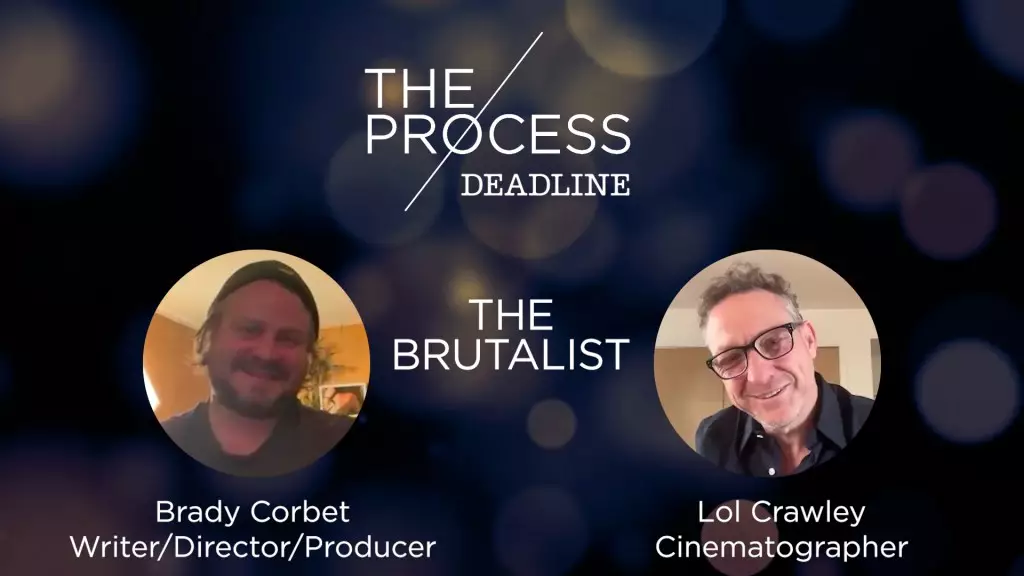Brady Corbet, an emerging force in contemporary cinema, has embarked on yet another compelling journey with “The Brutalist,” collaborating once again with the distinguished cinematographer Lol Crawley. Their synergy, previously demonstrated in the thought-provoking films “Vox Lux” and “The Childhood of a Leader,” has matured over the years, allowing for a deeper exploration of cinematic storytelling. In recent discussions, Corbet reflected on their creative process, describing it as both ambitious and intimate. This duality is intrinsic to their filmmaking approach, where vast thematic ideas are often conveyed through intimate, character-driven narratives.
Corbet’s creative vision is replete with complexity, often characterized by a paradoxical tension between ambition and limitation. While he intends for his films to resonate on a grand scale, he acknowledges a certain myopia during the writing process. The characters’ worlds may initially seem confined, but through collaboration with numerous talented individuals within the production team, these personal stories inevitably expand in breadth and impact. This metamorphosis from narrow vision to a broader cinematic experience is a testament to the collaborative nature of filmmaking, which Corbet now embraces with confidence, alleviating the anxiety that once accompanied his creative undertakings.
Crawley’s insights further illuminate the distinctive aesthetic that defines “The Brutalist.” He emphasizes the importance of creating cinematic language that intertwines performance with spatial dynamics. This nuanced understanding elevates the film’s pivotal moments, transforming them into powerful visual narratives. The duo’s ambition to capture these shifts through intricate shots necessitates an environment where spontaneity and structure coexist harmoniously. This exploration of aesthetics is remarkable, bridging the gap between artistic intention and viewer perception.
The conversation between Corbet and Crawley serves as a reflection on the often grueling experience of filming. Discussing the toll that production can take on those involved, they unveil the hidden struggles of maintaining creativity in a high-stress environment. What may be overlooked by audiences is the sheer intensity of a film set, where exhaustion may lead to frustration among the crew. Yet, this climate is precisely what fosters resilient creativity, enabling a unique camaraderie among the artists laboring to birth a new cinematic creation.
“The Brutalist” is set against the backdrop of a fragmented post-World War II landscape, asserting its narrative through the experiences of László Tóth, a Hungarian-Jewish architect portrayed by Adrien Brody. Tóth’s journey, laced with themes of survival, identity, and hope, resonates deeply within a historical context that remains painfully relevant. His migration to the United States, while isolated from his wife Erzségbet (Felicity Jones) and niece Zsófia (Raffey Cassidy) trapped in Eastern Europe, reflects a profound longing for connection, encapsulating the broader immigrant experience.
The film’s narrative is further bolstered by a stellar supporting cast, including Joe Alwyn, Stacy Martin, Isaach de Bankolé, and Alessandro Nivola. Their diverse performances lend authenticity to the storyline, enriching Tóth’s odyssey with layered complexities. This ensemble cast not only enhances individual character arcs but also creates a collective portrayal of resilience in the face of adversity, thus mirroring the film’s overarching themes.
Even before its full release, “The Brutalist” has garnered significant acclaim, capturing a Best Motion Picture Drama win at the Golden Globes alongside multiple Oscar and BAFTA nominations. Critics have lauded its ambition, thematic depth, and visual storytelling, noting the meticulous craftsmanship that both Corbet and Crawley bring to the table. As awards buzz continues to circulate, it appears that “The Brutalist” is poised to leave an indelible mark on the cinematic landscape.
Brady Corbet’s “The Brutalist” stands as a testament to the power of collaboration in film. Through intimate, character-driven narratives combined with grand visual storytelling, the film is set to engage audiences on emotional and intellectual levels. As the film continues to receive accolades and capture the attention of cinephiles worldwide, it is evident that Corbet and Crawley’s dynamic partnership has birthed yet another remarkable contribution to contemporary cinema. Their journey not only highlights the beauty of film as a collaborative art form but also provides a poignant reflection on the human experience amid the chaos of history.


Leave a Reply